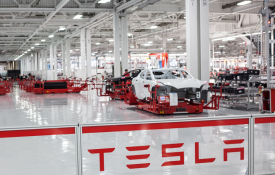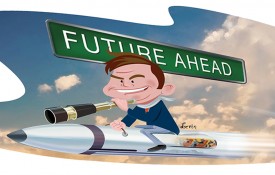Man had been shaving for millennia when Andy Katz-Mayfield entered a New York City drugstore one evening for an affordable razor. Eyeing the locked rack of over-priced devices, he recognized an unmet need. Not long after, he partnered with college friend (and Warby Parker co-founder) Jeff Raider to form Harry’s. The brand that started with direct-to-consumer razors has since evolved into a major omni-channel player in men’s care.
Launched around the same time as another disruptor (Dollar Shave Club), Harry’s sought to differentiate itself by providing an innovative, affordable solution. Their value proposition: consistent pricing across retail and online channels; a straightforward assortment of men’s care products that simplify options; honest ingredients; and a commitment to give one percent of all sales to causes that give back to men in need.
CSQ recently caught up with Katz-Mayfield as Harry’s preps for an anticipated combination with Edgewell (parent company of Schick) valued at $1.4B—a total that would eclipse the $1B Unilever deal Dollar Shave Club inked in 2016.
Did you feel the heat of competition for market share with Dollar Shave Club in 2012, when you were both fledgling companies?
I don’t think we ever considered Dollar Shave Club our primary competition. In retrospect, it was great because having them out there as an alternative, it caused a lot of people to consider that they had options. There’s one Goliath [Gillette] and then a whole lot of Davids. While we compete with Dollar Shave Club on some level in terms of mindspace and advertising dollars, I think there’s a number of insurgents that are chipping away at the monopolists.
How did you meet Jeff Raider and what is your working relationship like?
Jeff and I were college interns together. We worked together in private equity for five years, then came back together to build Harry’s. There is real value to having known someone for nearly 20 years. You share a deep trust and a shared set of values and worldview. We don’t disagree on too much. Over time, we’ve carved out certain areas of responsibility. Historically, Jeff spends more time on marketing, the brand, and the consumer experience. I spend more time on product R&D, and finance and operations. Beyond that, it’s really useful to have a thought partner—a peer you can bounce ideas off of.
How has the focus of the company evolved since the beginning?
We launched direct-to-consumer because it felt like a way that we could provide an overall better purchase experience. We felt that having a direct relationship with our customers would humanize the company and the brand. With that said, we never considered ourselves a VC company or a tech platform. We are a consumer products company, and so fundamentally at the end of the day, Harry’s is the brand. We still have a large, thriving direct-to-consumer business, but I think consumer brands in 2020 need to be omnichannel by definition and meet consumers where they shop. Sometimes that’s online, sometimes it’s direct, sometimes it’s Amazon, Target. So over time, we’ve expanded and become present in all those places, as long as we can do it in a way that we feel is consistent with our brand and providing customers with a good experience.

When did you first believe the brand to be successful?
In some ways, I’m not sure we’re there yet. Great, truly iconic brands get built over many, many years. There’s a lot of people who have never heard of Harry’s, so there’s lots of work to do to continue to build awareness and strong, differentiated equity. When we launched, there was so much enthusiasm and word-of-mouth, that was the first time we had any confidence that this proposition is resonating with people. Some of the success we’ve had in mass retail, too, has shown…that we aren’t exclusively a direct-to-consumer marketing engine. We didn’t just show up overnight.
How have you expanded upon the market niche you originally carved out for Harry’s?
We’ve diversified over the years, so while we are still rooted in shaving, we have a whole line of facial skin-care products, a bar soap, body wash line, and hair styling and care. All these are based on meeting a consumer need. In shaving, there was clearly an unmet need: a razor that worked well, at good value, and looked like it was designed for human beings and not for outer space. That was the original idea, but we still apply that same way of thinking for every new product and every new category. A consumer need could be price- or value-oriented, aesthetic, or a product-performance attribute.

Similarly, in the evolution of our company, we started with shaving and then the vision for the Harry’s brand, and of the overall company, expanded. In trying to build a diversified consumer products company, we’ve got the Harry’s brand, we’ve got Flamingo, which is our women’s brand, and we’ve got several other brands we’re working on in other categories, all driven by the same mindset: What is fundamentally missing from a consumer standpoint, and how can we meet that need?
What difficult challenges have you encountered and what lessons have you taken from them?
You get told no a lot. That’s certainly true when you’re asking investors for capital, or when you’re asking people to join your fledgling company when there’s only five or 10 of you. What I’ve learned along the way, is when someone says “no,” I just hear “maybe.” It’s like, “so you’re telling me there’s a chance. Let’s continue the conversation.” Eventually, somebody will say yes, and you can prove yourself and keep building on that. That’s not easy in the early days, to get used to rejection and ignore it. Once you do that, though, it can become empowering.
Harry’s recently set a goal to help 500,000 men gain access to quality mental health care by 2021. How has the company’s support of this cause been demonstrated?
We donate one percent of our revenue to social causes and partners. For the Harry’s brand, it has evolved over time, but the cause that we’ve really embraced the last couple of years is men’s mental health. There’s a public stigma around the issue, and we’re uniquely positioned to have an impact in that arena. Having a social responsibility has always been an important part of what we do. In our employee population, too, I think people like to work for an organization that they feel wants to make a positive impact aside from just the bottom line. It has been an important part of our company policy and strategy over the years.













































